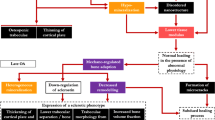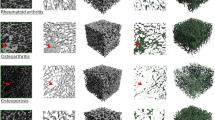Abstract
Bone eburnation is a common anatomical trace of chronic arthropathy. However, its topographical analysis in rheumatic diseases can contribute to knowledge about the latter, by explaining today’s diagnosis through radiology as well as by giving an historical perspective through paleopathology. After recalling that eburnated areas can also originate in infectious arthritis, the present analysis consists in a comparison between macroscopic and radiological observations of both osteoarthritis (OA) and rheumatoid arthritis (RA) at an advanced stage. It focuses on the human femoral head because of its demonstrative interest. Two main observations emerge from our study. The eburnated surface is less extensive in OA (where it appears to be essentially linked to the original structure of the hip) and more extensive in RA at an advanced stage (where an additional systemic factor is predominant). The size of the associated osteophytes appears to be inversely proportional to the extent of the corresponding eburnated area. In connection with the OA-RA comparison above, the contribution of the original joint structure to bone eburnation was also illustrated by acromiohumeral eburnation in shoulder OA and by the comparison with dog hip OA. It must also be noted that a femoral head bone remodeling similar on the whole to that of OA can occur in ochronotic arthropathies whose causal chondropathy is due to a genetic defect. Originating in an identified chondropathy, eburnation in ochronotic arthropathy gives us the opportunity to study an OA-type bone remodeling per se as in an experiment supplied by nature and involving a human hip. However, since RA and ochronotic arthropathy are due to a diffuse chondropathy, both may create a similar macroscopic (and thus radiological) eburnation topography.
Similar content being viewed by others
Abbreviations
- OA:
-
Osteoarthritis, osteoarthrosis
- RA:
-
Rheumatoid arthritis
References
Milgram J (1983) Morphologic alterations of the subchondral bone in advanced degenerative arthritis. Clin Orthop 173:293–312
Resnick D (2002) Degenerative disease of extraspinal locations. In: Resnick D (ed) Diagnosis of bone and joint disorders, 4th edn, vol 2. WB Saunders, Philadelphia, pp 1271–1381
Ruffer MA (1913) Studies in palaeopathology in Egypt. J Pathol Bacteriol 18:149–162
Lagier R (2001) Nosology versus pathology, two approaches to rheumatic diseases illustrated by Alfred Baring Garrod and Jean-Martin Charcot. Rheumatology (Oxford) 40:467–471
Lagier R (1988) Hip osteoarthrosis in dogs with an acetabular dysplasia: a pathological study. J Orthop Rheumatol 1:219–226
Lequesne M, Amouroux J (1970) La Coxarthrose destructrice rapide. Presse Med 32:1435–1439
Rosenberg ZS, Shankman S, Steiner GC, Kastenbaum DK, Norman A, Lazansky MG (1992) Rapid destructive osteoarthritis: clinical, radiographic, and pathologic features. Radiology 182:213–216
Kellgren JM, More R (1952) Generalized osteoarthritis and Heberden’s nodes. Br Med J 1:181–187
Garrod A (1923) Discussion on the aetiology and treatment of osteo-arthritis and rheumatoid arthritis. Proc R Soc Med XVII: 1–18
Lagier R (1980) The concept of osteoarthrotic remodeling as illustrated by ochronotic arthropathy of the hip-radiological and anatomico-radiological approach. Virchows Arch A Pathol Anat Histol 385:293–308
Lagier R (2004) Ochronotic arthropathy, an approach to osteoarthritis bone remodeling. Rheumatol Int (in press)
Lagier R, Steiger U (1980) Hip arthropathy in ochronosis: anatomical and radiological study. Skeletal Radiol 5:91–98
Lagier R (1995) Rheumatism as perceived by some quotations: as seen by the patient and physician. Rev Rhum Engl Ed 62:775–780
Rogers J, Shepstone L, Dieppe P (1997) Bone formers: osteophyte and enthesophyte formation are positively associated. Ann Rheum Dis 56:85–90
Crubézy E, Goulet J, Bruzek J, Jelinek J, Rougé D, Ludes B (2002) Epidemiology of osteoarthritis and enthesopathies in a European population dating back 7700 years. Joint Bone Spine 69:580–588
Rogers J, Shepstone L, Dieppe P (2004) Is osteoarthritis a systemic disorder of bone? Arthritis Rheum 50:452–457
Solomon L, Schnitzler CM, Bowett JP (1982) Osteoarthritis of the hip: the patient behind the disease. Ann Rheum Dis 41:118–125
Ortner DJ (2003) Identification of pathological conditions in human skeletal remains. Academic Press, New York
Rogers J, Dieppe P (1990) Skeletal paleopathology and the rheumatic diseases. Where are we now? Ann Rheum Dis 49:885–886
Rogers J, Dieppe P (1994) Is tibiofemoral osteoarthritis in the knee joint a new disease? Ann Rheum Dis 53:612–613
Kramar CH, Lagier R, Baud CA (1990) Rheumatic diseases in Neolithic and Medieval populations of Western Switzerland. Z Rheumatol 49:338–345
Eisenstein SM, Parry CR (1987) The lumbar facet arthrosis syndrome. Clinical presentation and articular surface changes. J Bone Joint Surg Br 69:3–7
Author information
Authors and Affiliations
Additional information
Published online: 23 December 2005
R. Lagier died in December 2004.
«C’est dans l’observation des sujets humbles qu’il y a la plus riche matière à réflexion»—“The observation of modest subjects is the richest food for thought.” René Leriche, La philosophie de la chirurgie, 1951.
Rights and permissions
About this article
Cite this article
Lagier, R. Bone eburnation in rheumatic diseases: a guiding trace in today’s radiological diagnosis and in paleopathology. Clin Rheumatol 25, 127–131 (2006). https://doi.org/10.1007/s10067-004-1055-8
Received:
Accepted:
Issue Date:
DOI: https://doi.org/10.1007/s10067-004-1055-8




